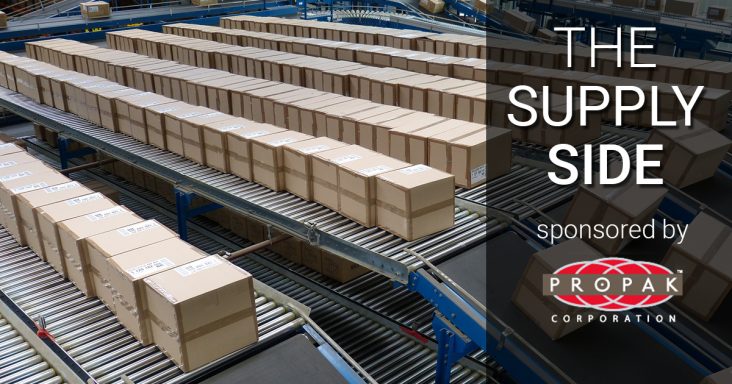The Supply Side: Supply challenges, inflation to persist in 2022
by January 8, 2022 9:10 am 1,215 views

While the backlog of inventory is easing, supply chain executive Kevin Williamson predicts it will be the middle or even late 2022 before the flow of goods and order cancellations improve.
Williamson, CEO of Chicago-based RJW Logistics Group, said that during the first half of 2021, order cancellations rose to the mid-single digits as manufacturers struggled with workforce challenges and lack of raw materials. He said that the order cancellations rose in recent weeks as the COVID-19 omicron variant pushed up new infection rates. Williamson said his third-party supply chain firm has been advising its roughly 500 consumer packaged goods (CPG) clients to hoard all the raw materials they could as demand does not look to abate before 2023.
Williamson said retailers like Walmart, Target and Kroger would be forced to offer more niche brands if legacy CPG companies cannot fulfill the uptick in orders.
“While it’s very hard to build just-in-case inventory right now, that is exactly what CPG companies need to be doing. We can be sure there will be other variants to the COVID-19 virus, and if demand surges with each new variant, there is going to be continued stresses on the supply chain,” Williamson said.
He said firms like RJW also have beefed up their assets. That means adding trailers and hauling capacity and applying advanced analytics to increase efficiency and improve inventory visibility throughout the supply chain.
RJW is a middle-mile supply chain company. The firm focuses on being a supply chain partner for CPG companies and their mega-mass retail customers. Williamson said that his firm saw unprecedented demand during the pandemic as retailer shelves were empty across the nation. He said many RJW customers had production abroad that went off-line, and companies from popcorn makers to peanut butter and soup manufacturers had trouble sourcing raw materials after depleting their inventory.
While Williamson does not expect product shortfalls to persist beyond 2023, it could be that long before many companies have replenished inventory. In the meantime, he said that creates opportunities for emerging brands that can be more nimble to perhaps chip away at market share. He said product availability could be difficult in some categories, such as semiconductors and commodities. Prices of supplies will likely be high and rise more for some raw materials. He said companies have no choice but to pass higher prices to customers as inflation will persist through 2022 and part of 2023. Higher wages amid the talent and worker shortfalls are also likely to continue creating additional challenges for business recovery in 2022.
Supply chain disruptions have also created many challenges for suppliers’ customer service agents. Research firm Forrester expects brands will lose 50% of sales of back-ordered items unless they compensate with a proactive customer experience. Forrester said that includes managing the churn and pressure on customer service center agents who have to deal with angry customers while also recommending solutions and alternatives to items stuck in the supply chain.
Another challenge manufacturers and their suppliers will continue to face in 2022 include increased demand for shipping and home delivery which will exceed the industry’s capacity, according to supply chain insiders. That will drive final-mile prices higher.
“COVID-19 exposed vulnerabilities in the supply chain and the continued meltdown combined with increasing consumer demand for real-time delivery will drive more investment in logistics and e-commerce capabilities,” according to Lindsey Gray of Two Sigma Ventures.
She said retailers like Sephora are launching single-day delivery to compete with Amazon and get ahead of supply chain issues, and more companies will follow suit — including small businesses. Walmart just signed up ladies fashion retailer Chico to its GoLocal home delivery platform, and the retail giant continues to shop that service to retailers of all sizes.
Gray said businesses of all kinds will need to invest in supply chain and logistics capabilities, including tracking, last-mile delivery and e-commerce in 2022 and beyond if they want to remain competitive.
Williamson said it’s never been more important for suppliers to communicate with their retail partners about inflationary pressures. He said the conversations should be thoughtful and come after a supplier has already made several attempts to mitigate inflation through finding efficiencies within their operations. Williamson said that he talks daily with top management teams at CPG manufacturers, and better forecasting of demand was sorely needed when the pandemic hit. RJW’s internal forecasting tool was turned outward and made available to CPG clients. He said the device gave those suppliers better visibility into demand and helped them to set plans in motion to keep lines moving and trucks rolling. Williamson said some CPG customers tried near-shoring raw materials and product ingredients to keep plants running.
While the worst of the pandemic appears to be over, Williamson said additional surges in the virus variants are likely to become a way of life for the foreseeable future. He noted that CPG companies’ investments in higher wages, higher raw material costs, and inventory restocking have squeezed operating margins with no relief in sight.
He said supply chain efficiency has never been more essential, and suppliers, their third-party logistics partners and retailers must each do more to find cost savings where they can and pass along the difference.
Editor’s note: The Supply Side section of Talk Business & Politics focuses on the companies, organizations, issues and individuals engaged in providing products and services to retailers. The Supply Side is managed by Talk Business & Politics and sponsored by Propak Logistics.
